What is perlite?
The progenitor of perlite is obsidian, a shiny black volcanic glass. For many years it is washed by groundwater, which causes a slow hydration reaction, the formation of crystal hydrates, the melting point of the material decreases and it becomes possible to soften it in factory conditions.
The mined perlite is crushed into small fractions and subjected to thermal shock at a temperature of 900-1100 °C. The bound water is released explosively, forming millions of small bubbles and increasing the volume of the original raw material by 5-20 times. This process is called swelling.
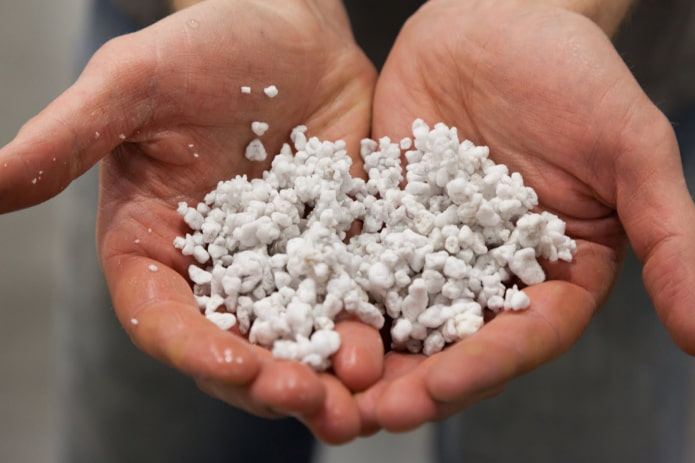
The material becomes brittle, and its porosity reaches 90%. Expanded perlite resembles crumbled polyurethane foam or cat litter. The color varies from dirty gray to snow-white, the granules are easily rubbed between your fingers, but you need to be careful – this is former glass, a strong abrasive that can scratch the skin.
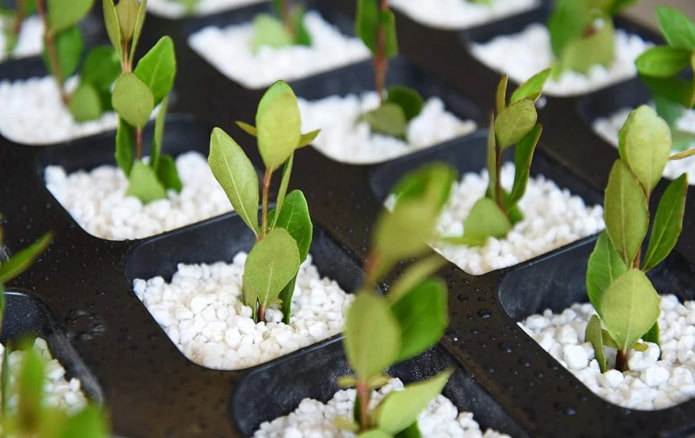
The scope of application of perlite is wide and depends on the fraction:
- construction – granules from 0.16 to 20 mm, density 75-200 kg / m³, used for insulation of houses and filling lightweight concrete;
- agroperlite – granules from 0.63 to 5 mm, density no higher than 160 kg / m³, widely used in agriculture farming, floriculture, hydroponics, landscape art;
- perlite powder – granules from 0.01 to 0.16 mm, acts as a filler for filters in the food, oil and gas and medical industries.
Perlite properties:
- neutral (pH = 7);
- perlite is able to adsorb water in a volume four times greater than its own;
- does not contain anything at all, neither mineral salts nor organic substances;
- is not subject to either biological or chemical decomposition.
What is vermiculite?
For this valuable assistant, we should thank hydromica, which has a much more complex composition than obsidian. Iron and magnesium compounds usually predominate. Since hydromica has been subjected to water and wind erosion for centuries, there are almost no soluble salts left in it, but they appear in the process of destruction of crystal hydrates.
The main difference of perlite is that vermiculite can be considered as a mineral fertilizer and a natural growth stimulator.
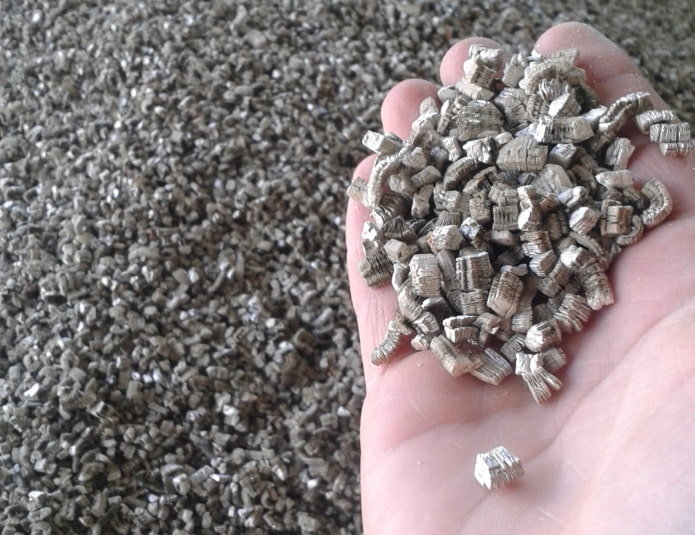
Vermiculite is obtained from hydromica in three stages, the final stage is also a thermal shock, but at a temperature slightly lower – 850-880 °C. But the result looks even more impressive: the material increases in volume by at least 15 times and acquires the ability to absorb water 5 times more than its own weight.
Vermiculite is divided into types according to the features of its composition:
- copper vermiculite;
- biotite – with a predominance of iron;
- batavite – without iron;
- lucasite – chrome.
The composition affects the color, which can be black, gray, greenish, brown, red-brown, golden-yellow. Vermiculite retains its similarity to mica, it is relatively flexible and soft, non-abrasive and is an elongated crystal with jagged edges, that is, its appearance is very different from perlite.
The scope of vermiculite is exactly the same, and in construction it is sometimes preferable, since it is better suited for the production of refractory materials and laying foundations.
Agriculture uses agrovermiculite with a granule size of 0.8-5 mm.
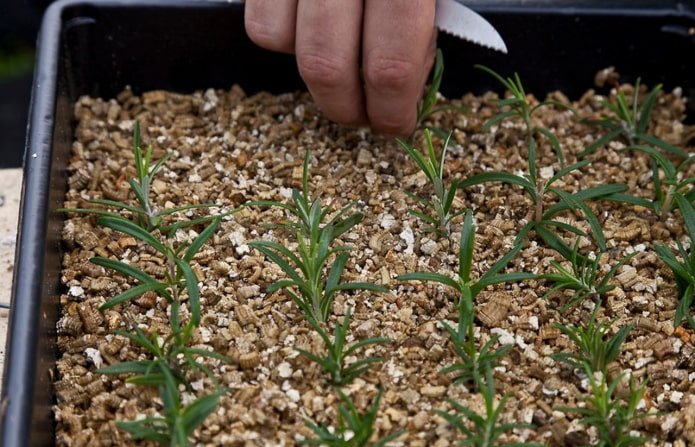
The properties of vermiculite are similar to the properties of perlite, only two indicators differ slightly:
- density ― 65-130 kg/m³;
- porosity ― 65-90%.
What is the difference?
The substances are similar in many parameters, but they have significant differences in terms of their impact on plants.
Before identifying and honoring the leader, it would be fair to study the advantages and disadvantages of each of the candidates.
- improves aeration of the root system;
- perlite absorbs excess moisture well;
- does not weigh down the pot due to its lightness;
- due to low thermal conductivity, perlite retains heat in the cold season;
- neutral acidity allows it to be used in various soil mixtures.
- electrically neutral, therefore does not participate in ion-cation exchange;
- when watered with hard water and regularly adding potassium and sodium, perlite leads to leaching of the soil, and this is unacceptable for crops that prefer slightly acidic soils;
- fragile, with active loosening of the beds it quickly crumbles into dust and ceases to cope with the tasks assigned, except In addition, this dust is harmful to inhale;
- abrasive, so it requires careful use.
- vermiculite perfectly regulates the level of nitrates in the soil by retaining nitrogen compounds;
- a good adsorbent, which allows it to evenly release moisture, and, if necessary, absorbs it from the air;
- is an excellent ingredient for drainage, because it retains its structure for a long time;
- vermiculite does not damage the roots when transplanting.
- in a warm, humid climate and in clay soils, vermiculite promotes the development of microalgae colonies;
- costs several times more than perlite, which makes its use in large farms unprofitable, despite all the advantages.
Both of these substances are environmentally friendly and belong to class 4.
Also watch an interesting video:
What is better?
So, let’s sum it up. If we are talking about indoor floriculture, preparing seedlings and cuttings for a small personal garden or flower bed, the issue of volumes and costs fades into the background, so we can safely recommend vermiculite. And when it comes to huge agricultural areas or hydroponic complexes, it is wiser to choose agroperlite. I have prepared a summary table to better understand in which cases perlite is suitable, and in which vermiculite.
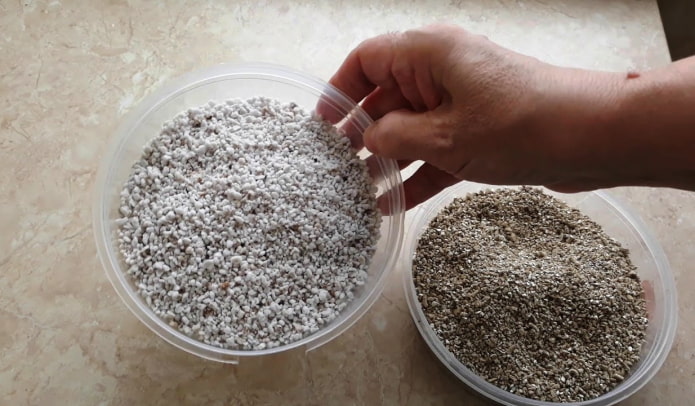
There is an option to mix these additives in half or take 40% vermiculite + 60% agroperlite. In total, the soil should contain from 10 to 50% of the mixture, regardless of its composition. For heavy and dense soils, such as black soil, it is better to take 45-50%.
Perlite has useful qualities, but vermiculite is not far behind, so they fully justify their cost. Whatever choice you make, it will be better than the decision not to use either option.
Now reading:
- Bedroom Design Ideas 20 sq.m: Inspiration and 30 Interior Photos
- 12 Creative Solutions for Zoning a Compact Studio
- World Map in Interior Design: Characteristics and Examples of Images
- Bedroom without a window: 35 eye-catching images and useful tips.
- 60 ideas and inspiring photos of white kitchen interiors with wood countertops